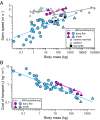Comparative analyses of animal-tracking data reveal ecological significance of endothermy in fishes
- PMID: 25902489
- PMCID: PMC4434765
- DOI: 10.1073/pnas.1500316112
Comparative analyses of animal-tracking data reveal ecological significance of endothermy in fishes
Abstract
Despite long evolutionary separations, several sharks and tunas share the ability to maintain slow-twitch, aerobic red muscle (RM) warmer than ambient water. Proximate causes of RM endothermy are well understood, but ultimate causes are unclear. Two advantages often proposed are thermal niche expansion and elevated cruising speeds. The thermal niche hypothesis is generally supported, because fishes with RM endothermy often exhibit greater tolerance to broad temperature ranges. In contrast, whether fishes with RM endothermy cruise faster, and achieve any ecological benefits from doing so, remains unclear. Here, we compiled data recorded by modern animal-tracking tools for a variety of free-swimming marine vertebrates. Using phylogenetically informed allometry, we show that both cruising speeds and maximum annual migration ranges of fishes with RM endothermy are 2-3 times greater than fishes without it, and comparable to nonfish endotherms (i.e., penguins and marine mammals). The estimated cost of transport of fishes with RM endothermy is twice that of fishes without it. We suggest that the high energetic cost of RM endothermy in fishes is offset by the benefit of elevated cruising speeds, which not only increase prey encounter rates, but also enable larger-scale annual migrations and potentially greater access to seasonally available resources.
Keywords: body temperature; marine predator; migration; swim speed.
Conflict of interest statement
The authors declare no conflict of interest.
Figures



Similar articles
-
Evolution and consequences of endothermy in fishes.Physiol Biochem Zool. 2004 Nov-Dec;77(6):998-1018. doi: 10.1086/423743. Physiol Biochem Zool. 2004. PMID: 15674772 Review.
-
Thermal effects on red muscle contractile performance in deep-diving, large-bodied fishes.Fish Physiol Biochem. 2020 Oct;46(5):1833-1845. doi: 10.1007/s10695-020-00831-7. Epub 2020 Jun 25. Fish Physiol Biochem. 2020. PMID: 32588156
-
Seasonal reproductive endothermy in tegu lizards.Sci Adv. 2016 Jan 22;2(1):e1500951. doi: 10.1126/sciadv.1500951. eCollection 2016 Jan. Sci Adv. 2016. PMID: 26844295 Free PMC article.
-
Review: Analysis of the evolutionary convergence for high performance swimming in lamnid sharks and tunas.Comp Biochem Physiol A Mol Integr Physiol. 2001 Jun;129(2-3):695-726. doi: 10.1016/s1095-6433(01)00333-6. Comp Biochem Physiol A Mol Integr Physiol. 2001. PMID: 11423338 Review.
-
Direct measurement of cruising and burst swimming speeds of the shortfin mako shark (Isurus oxyrinchus) with estimates of field metabolic rate.J Fish Biol. 2023 Nov;103(5):864-883. doi: 10.1111/jfb.15475. Epub 2023 Jul 4. J Fish Biol. 2023. PMID: 37395550 Free PMC article.
Cited by
-
The extinct shark Otodus megalodon was a transoceanic superpredator: Inferences from 3D modeling.Sci Adv. 2022 Aug 19;8(33):eabm9424. doi: 10.1126/sciadv.abm9424. Epub 2022 Aug 17. Sci Adv. 2022. PMID: 35977007 Free PMC article.
-
Endothermic physiology of extinct megatooth sharks.Proc Natl Acad Sci U S A. 2023 Jul 4;120(27):e2218153120. doi: 10.1073/pnas.2218153120. Epub 2023 Jun 26. Proc Natl Acad Sci U S A. 2023. PMID: 37364100 Free PMC article.
-
The living dinosaur: accomplishments and challenges of reconstructing dinosaur physiology.Biol Lett. 2025 May;21(5):20250126. doi: 10.1098/rsbl.2025.0126. Epub 2025 May 29. Biol Lett. 2025. PMID: 40438994 Free PMC article. Review.
-
Scaling of swim speed in sharks: a reply to Morrison (2016).Biol Lett. 2016 Aug;12(8):20160502. doi: 10.1098/rsbl.2016.0502. Biol Lett. 2016. PMID: 27531161 Free PMC article. No abstract available.
-
Is the scaling of swim speed in sharks driven by metabolism?Biol Lett. 2015 Dec;11(12):20150781. doi: 10.1098/rsbl.2015.0781. Biol Lett. 2015. PMID: 26631246 Free PMC article.
References
-
- Davy J. On the temperature of some fishes of the genus Thunnus. Philos Trans R Soc Lond B Biol Sci. 1835;•••:327–328.
-
- Dickson KA, Graham JB. Evolution and consequences of endothermy in fishes. Physiol Biochem Zool. 2004;77(6):998–1018. - PubMed
-
- Bernal D, Sepulveda CA. Evidence for temperature elevation in the aerobic swimming musculature of the common thresher shark, Alopias vulpinus. Copeia. 2005;2005(1):146–151.
-
- Block BA, Finnerty JR, Stewart AFR, Kidd J. Evolution of endothermy in fish: Mapping physiological traits on a molecular phylogeny. Science. 1993;260(5105):210–214. - PubMed
Publication types
MeSH terms
LinkOut - more resources
Full Text Sources
Other Literature Sources

